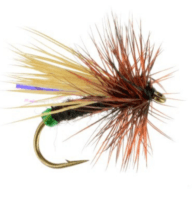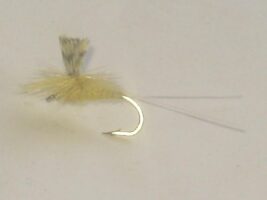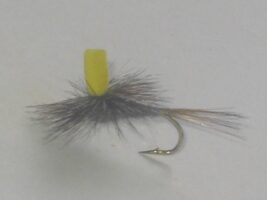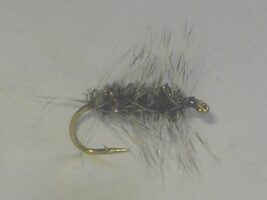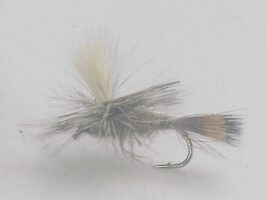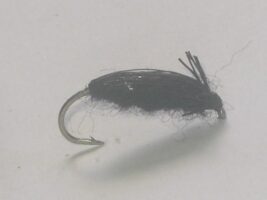Your cart is currently empty!
Grannom Caddis Dry Fly
Historical Significance and Pattern Evolution The Grannom Caddis Dry Fly represents one of the most important early-season patterns in fly fishing, particularly celebrated for its effectiveness during the April Grannom (Brachycentrus subnubilus) hatch. This pattern imitates the first significant caddis emergence of the year, which often prompts trout to begin surface feeding. Originally developed to…
Description
Historical Significance and Pattern Evolution
The Grannom Caddis Dry Fly represents one of the most important early-season patterns in fly fishing, particularly celebrated for its effectiveness during the April Grannom (Brachycentrus subnubilus) hatch. This pattern imitates the first significant caddis emergence of the year, which often prompts trout to begin surface feeding. Originally developed to match the distinctive dark purple-brown body and broad-winged profile of adult Grannom caddis, this pattern has evolved to include various interpretations while maintaining its essential characteristics.
Premium Materials and Construction Details
Essential Materials List:
- Hook: Dry fly hook (sizes 14-16)
- Thread: Dark brown or black 8/0
- Body: Dark purple-brown dubbing
- Wing: CDC or deer hair
- Thorax: Darker dubbing
- Hackle: Brown or grizzly
- Optional: Green egg sac material
- Head: Thread with clear finish
- Rib: Fine copper wire (optional)
- Tag: Fluorescent green (optional)
Material Selection Considerations:
- Hook size matches natural insects
- Thread strength affects durability
- Body dubbing creates proper profile
- Wing material affects flotation
- Hackle quality determines float
- Egg sac material for female version
- Rib material adds segmentation
- Head finish protects materials
- Material preparation affects profile
- Storage conditions preserve materials
Detailed Tying Instructions
Preparation Steps:
- Select appropriate hook size
- Choose quality materials
- Prepare wing material
- Select hackle feather
- Organize workspace
- Check tools
- Plan proportions
- Review pattern
- Test thread strength
- Prepare dubbing
Step-by-Step Tying Sequence:
- Start thread behind eye
- Create uniform thread base
- Tie in optional tag
- Form tapered body
- Add ribbing if desired
- Tie in wing
- Add hackle
- Build neat head
- Whip finish
- Apply head cement
- Check proportions
- Test flotation
Advanced Fishing Techniques
Presentation Methods:
- Dead drift presentation
- Slight twitches
- Downstream drift
- Upstream presentation
- Cross-current fishing
- Film fishing
- Current seam presentation
- Structure approaches
- Pattern combinations
- Selective fish tactics
Water Reading Skills:
- Identify feeding lanes
- Recognize current breaks
- Spot rising fish
- Detect surface activity
- Read water clarity
- Locate prime lies
- Find transition zones
- Identify temperature breaks
- Track fish movement
- Monitor insect activity
Seasonal Strategies
Early Spring Tactics:
- Match early hatches
- Focus on warming water
- Target active fish
- Adjust presentation
- Monitor temperatures
- Watch for rises
- Follow fish movement
- Time presentations
- Adapt to conditions
- Match natural drift
Peak Hatch Applications:
- Early morning fishing
- Late evening sessions
- Target egg-laying females
- Focus on riffles
- Match daily patterns
- Observe feeding windows
- Adjust to conditions
- Monitor water levels
- Watch temperatures
- Time presentations
Late Season Approaches:
- Match scattered hatches
- Target feeding fish
- Adjust presentation style
- Watch water conditions
- Monitor temperatures
- Follow movement patterns
- Adapt to weather
- Time efforts effectively
- Match natural drift
- Adjust techniques
Technical Rigging Considerations
Leader Construction:
- Tapered leaders
- Quality tippet material
- Proper diameter selection
- Breaking strength considerations
- Length adjustments
- Material choices
- Knot selection
- Visibility factors
- Float characteristics
- Setup variations
Terminal Tackle:
- Direct connection methods
- Leader construction
- Line control
- Strike detection
- Float adjustment
- Pattern spacing
- Drift control
- Presentation angles
- Setup modifications
- Tippet selection
Habitat-Specific Tactics
Water Types:
- Freestone streams
- Spring creeks
- Tailwaters
- Small brooks
- Large rivers
- Mixed waters
- Clear streams
- Pocket water
- Riffles
- Pools
Specific Locations:
- Feeding lanes
- Current seams
- Structure edges
- Bank water
- Mid-stream
- Transitions
- Drop-offs
- Shallow flats
- Deep runs
- Protected areas
Advanced Presentation Methods
Traditional Techniques:
- Upstream dry fly
- Downstream presentation
- Cross-current drift
- Reach cast
- Pile cast
- Parachute cast
- Aerial mend
- Stack mend
- Curve cast
- Wiggle cast
Modern Adaptations:
- Multiple fly rigs
- Indicator techniques
- Film fishing methods
- Edge water tactics
- Structure approaches
- Pattern combinations
- Presentation modifications
- Depth control
- Speed variations
- Drift management
Pattern Variations
Size Considerations:
- Match natural insects
- Consider water type
- Adapt to pressure
- Account for clarity
- Follow seasonal trends
- Consider fish size
- Match preferences
- Adapt to conditions
- Consider speed
- Match forage base
Style Variations:
- Traditional hackled
- CDC wing
- Deer hair wing
- Egg-laying female
- No-hackle variant
- Thorax style
- Film variant
- Low-floating version
- High-floating version
- Spent pattern
The Grannom Caddis Dry Fly represents the perfect combination of traditional design and practical effectiveness. Its carefully selected materials and precise construction ensure consistent performance across various fishing conditions. Whether targeting selective trout during specific hatches or searching for opportunistic feeders, this pattern provides the perfect tool for successful dry fly fishing throughout the season.
Additional information
| Hook size | 10, 12, 14, 16, 18, 20, 22 |
|---|---|
| Hook type | Barbed Hooks, Barbless Hooks |

